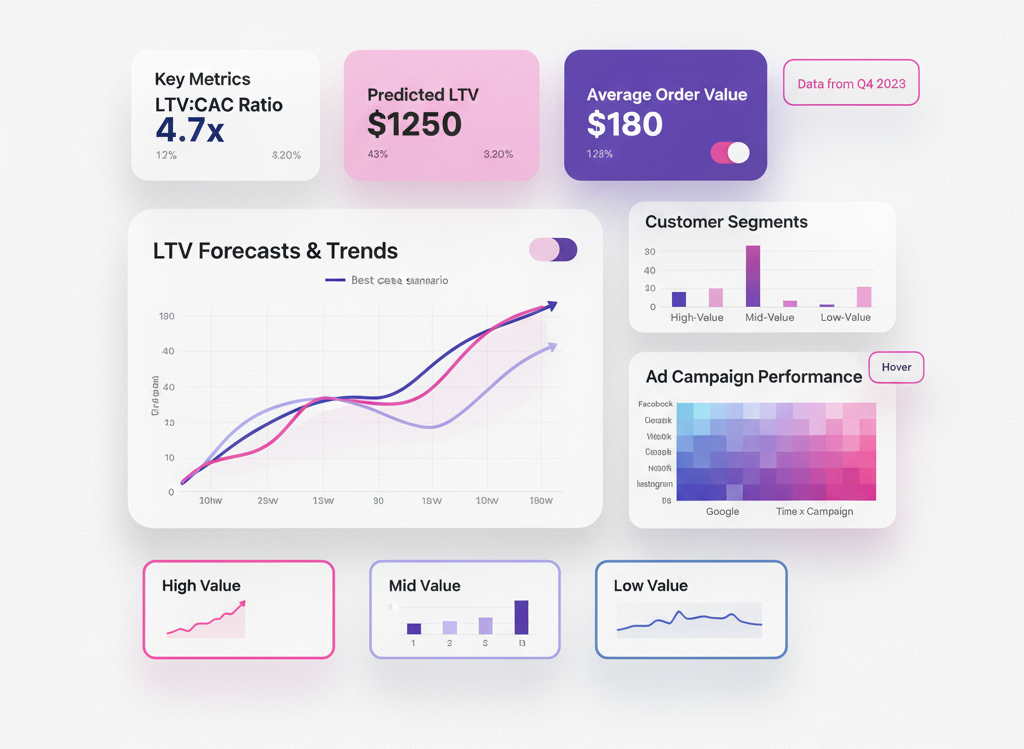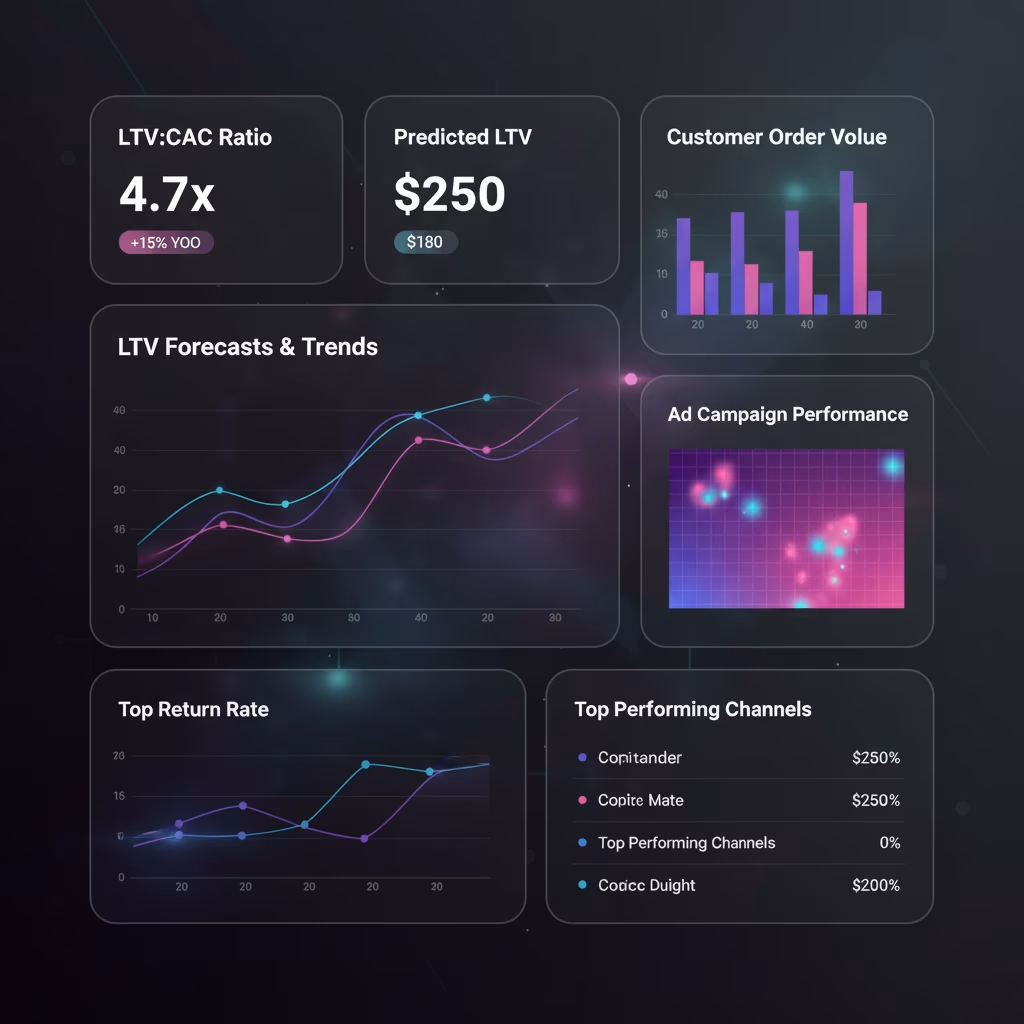In today's competitive e-commerce landscape, relying solely on return on ad spend (ROAS) is no longer sufficient for long-term success. Forward-thinking brands are turning to predictive modeling to forecast customer lifetime value (LTV) and optimize advertising strategies for maximum profitability. This article explores how mastering predictive modeling can unlock hidden LTV growth secrets, empowering D2C founders and marketing directors to achieve scalable, data-driven growth.
Understanding Predictive Modeling in E-commerce
Table of Contents
Predictive modeling leverages advanced algorithms and machine learning to analyze historical data, customer behavior patterns, and market trends to forecast future outcomes. In e-commerce, this means accurately predicting a customer's lifetime value—the total revenue they will generate over time. Unlike basic metrics like ROAS, which focus on immediate returns, LTV provides a holistic view of customer profitability, enabling brands to allocate ad budgets more strategically.
- LTV:CAC Ratio: Measures lifetime value against customer acquisition cost, ensuring sustainable growth when above 3:1.
- Value-Based Bidding: Adjusts ad bids based on predicted LTV, prioritizing high-value customers.
- Churn Prediction: Identifies at-risk customers early, allowing proactive retention efforts to maximize LTV.
Current Trends Shaping LTV Optimization
The e-commerce advertising sector is witnessing a paradigm shift towards AI-driven personalization and predictive analytics. With rising ad costs on platforms like Meta and Google, brands are compelled to adopt sophisticated tools that go beyond surface-level metrics. Recent developments include the integration of first-party data with AI models to comply with privacy regulations while enhancing prediction accuracy. This trend is accelerating as more D2C brands recognize that optimizing for LTV can increase profitability by up to 200% over traditional approaches.
Moreover, the rise of cookieless tracking has pushed marketers towards probabilistic modeling, where AI fills data gaps with high-confidence predictions. Adzeta.io is at the forefront, offering seamless integration of these trends into everyday campaigns for mid-market brands.
Overcoming Key Challenges with AI Solutions
E-commerce leaders often grapple with inaccurate forecasting, siloed data sources, and inefficient ad spend allocation. These pain points lead to missed opportunities and eroded margins. For instance, without predictive insights, brands may over-invest in low-LTV customers, resulting in a suboptimal LTV:CAC ratio. Adzeta's AI-powered platform addresses these by unifying data streams and delivering real-time LTV predictions, enabling precise targeting and bidding adjustments.
AI-Driven Data Integration
Seamlessly combines e-commerce, ad, and analytics data for comprehensive LTV modeling.
Real-Time Predictions
Forecasts LTV with over 90% accuracy, adapting to market changes instantly.
Automated Optimization
Implements value-based bidding to maximize ROI and scale profitably.

Practical Strategies to Implement Predictive Modeling
Implementing predictive modeling doesn't require a complete overhaul. Start by auditing your data quality and integrating key sources. Then, leverage AI tools to build models that predict LTV based on variables like purchase frequency, average order value, and engagement metrics. Best practices include segmenting audiences by predicted LTV tiers and tailoring campaigns accordingly—high-LTV segments receive premium nurturing, while low-LTV ones are acquired cost-effectively.
Gather and Clean Data
Collect historical customer data from your e-commerce platform and ad accounts, ensuring accuracy and completeness for reliable modeling.
Build Predictive Models
Use AI algorithms to analyze patterns and forecast LTV, incorporating factors like seasonality and market trends.
Optimize Campaigns
Apply insights to adjust bidding strategies, targeting high-value prospects to drive efficient growth.
Monitor and Iterate
Track performance metrics and refine models continuously for sustained improvements in profitability.
Real-World Results and Success Metrics
Brands using Adzeta's predictive modeling have seen transformative results. For example, a mid-market D2C apparel brand increased their LTV by 150% within six months by shifting to value-based bidding. Supporting statistics highlight the impact: e-commerce companies adopting AI-driven LTV strategies report 30-50% higher retention rates and up to 40% lower acquisition costs. These outcomes underscore the power of predictive modeling in unlocking profitable growth.
Adzeta's predictive modeling turned our ad spend into a profit engine. We've unlocked LTV growth we never thought possible.
Key Takeaways
- Predictive modeling shifts focus from short-term ROAS to long-term LTV for sustainable growth.
- AI integration overcomes data silos and forecasting inaccuracies.
- Implementing step-by-step strategies yields measurable ROI improvements.
Ready to Unlock Your LTV Growth Potential?
Transform your e-commerce advertising with Adzeta's AI-powered predictive modeling. Schedule a demo today and start driving profitable, scalable growth.
Get Started Now
